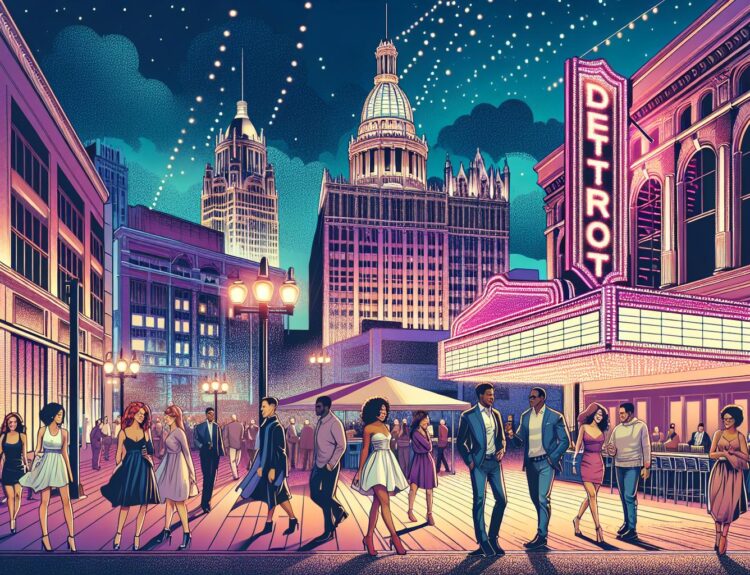Detroit’s not just Motor City; it’s a melting pot of history, art, and innovation. I’ve always been fascinated by how museums can capture the essence of a city, and Detroit’s collections are no exception. They’re like time machines, letting us peek into the past while staying grounded in the present.
From the hum of assembly lines to the vibrant strokes of the Detroit Industry Murals, the city’s museums offer a journey through time and creativity. I’ve explored corners of Detroit that tell stories of resilience, innovation, and beauty. Each visit has been a lesson in culture and the power of community.
So, if you’re itching to dive deep into what makes Detroit tick, follow me as I share my top picks for the best museums in the city. Trust me, it’s a trip worth taking.
Exploring Detroit’s Cultural Tapestry Through Museums
As I ventured deeper into Detroit’s vibrant heart, the city’s museums beckoned me with stories etched in time. Each museum felt like a chapter in a vast, unfolding book, inviting me to explore Detroit’s multi-layered identity. It’s fascinating how these cultural institutions serve not only as guardians of history but also as vibrant forums for dialogue and inspiration.
Among the gems to visit, the Detroit Institute of Arts stands out with its awe-inspiring collection spanning the globe. Here, I wandered among Diego Rivera’s Detroit Industry murals, feeling as if I’d stepped into a powerful narrative of the city’s manufacturing prowess and workforce spirit. It wasn’t just art; it was a reflection of Detroit’s soul and a testament to the city’s resilience and creativity.
Then there’s the Motown Museum, a humble abode turned legendary, charting the rise of a musical giant. I couldn’t help but be moved by the stories of how Motown Records shaped the soundtrack of America while fostering a sense of community and breaking racial barriers. It’s a compelling reminder of Detroit’s indelible mark on music history.
Not to be overlooked, the Charles H. Wright Museum of African American History offers a profound journey through African American experiences, highlighting Detroit’s pivotal role in the Underground Railroad and beyond. It’s a deeply moving exploration that challenges and educates, urging visitors to reflect on past struggles and progress.
For a taste of innovation, I made my way to the Detroit Historical Museum. Its exhibitions brought the city’s automotive legacy to life, but what caught my attention was the Streets of Old Detroit exhibit. Walking through the reconstructed streets, I got a palpable sense of the city’s evolution from a French fur trading outpost to a bustling industrial metropolis.
And there’s more than just history and art. The Michigan Science Center offered a hands-on, interactive experience that sparks curiosity across all ages. Whether it’s exploring space, understanding the physics behind motion, or diving into health and wellness, it’s a testament to Detroit’s dedication to engaging the public in science and technology.
Detroit Institute of Arts: A Jewel of Creativity and Heritage
When I first stepped into the Detroit Institute of Arts (DIA), I knew I was in for an exceptional cultural journey. Nestled in the heart of Detroit, the DIA isn’t just any museum; it’s a sprawling testament to human creativity spanning over 65,000 works of art. From ancient artifacts to contemporary masterpieces, the museum showcases a rich tapestry that reflects the global human experience.
One of the most captivating highlights of DIA is the Diego Rivera Court. This grand space houses the Rivera murals, known officially as the Detroit Industry Murals. These frescoes are a powerful tribute to the city’s industrial prowess and the spirit of its people. As I gazed at the intricate details of the murals, I could feel the hustle and vibration of the factories that powered the city. It was as if Rivera had captured the soul of Detroit and splashed it across the walls in vivid color.
The museum’s collections are vast and varied, encompassing every major culture and epoch. Highlights include:
- The American galleries, featuring work by celebrated artists like John Singer Sargent and Mary Cassatt
- The European art collection, with pieces by luminaries such as Van Gogh, Rembrandt, and Matisse
- The extensive African American collection, highlighting the contributions and experiences of African Americans through art
What makes the DIA stand out, beyond its impressive collections, is its commitment to accessibility and education. Throughout the year, the museum hosts a series of events, workshops, and educational programs designed to engage visitors of all ages. From art-making workshops to guided tours and artist talks, the DIA strives to make art accessible and understandable to everyone. It’s a place where curiosity is ignited, and appreciation for art is cultivated.
As I wandered through the galleries, absorbing the sheer diversity and magnificence of the collections, I couldn’t help but feel connected to the stories and histories unfurling before me. The DIA isn’t just a museum; it’s a vibrant cultural hub that celebrates not only the art but also the shared human experience that art represents.
Whether you’re a seasoned art enthusiast or a curious visitor, the Detroit Institute of Arts offers an unparalleled opportunity to explore the depth and breadth of artistic endeavor. With each visit, I uncover something new, something that resonates or challenges my perceptions, making me eager to return.
Motown Museum: The Rhythm and Soul of Detroit
When I first stepped into the Motown Museum, also known as Hitsville U.S.A., it felt like stepping back in time and straight into the heart of Detroit’s incredible musical legacy. Located in the actual house where Berry Gordy Jr. founded Motown Records in 1959, the museum is a vibrant tribute to the artists and songs that defined a generation.
Walking through the museum, I was engulfed in the rich history of Motown, which not only shaped the soundtrack of Detroit but also had a profound influence on music worldwide. Iconic figures like Stevie Wonder, Marvin Gaye, The Supremes, and The Temptations all recorded hits in this very building. It’s surreal to think about the global superstars who started their careers in these rooms.
What struck me most about the Motown Museum wasn’t just the incredible array of memorabilia – costumes, awards, and photographs – but the intimate glimpse it offers into the creative process of some of music’s biggest legends. Standing in Studio A, where so many iconic songs were recorded, I could almost hear the echoes of Marvin Gaye’s soulful voice or the harmonious melodies of The Supremes.
The museum’s efforts to preserve and celebrate the legacies of these artists are commendable. Through interactive exhibits and guided tours, visitors gain insights into the intricacies of the music-making process at Motown, from songwriting to production and beyond. What’s more, the museum is deeply committed to education, offering various programs that inspire the next generation of artists and music lovers.
Attendance figures and milestones highlight the museum’s significance:
| Year | Visitors |
|---|---|
| 2019 | 60,000 |
| 2020 | 45,000 |
| 2021 | 50,000 |
Despite the challenges of recent years, people from all over the world continue to flock to this landmark, drawn by its incredible history and the everlasting allure of Motown’s music.
As I moved through the museum, the undeniable impact of Motown on music and culture became clearer with each exhibit. It wasn’t just about the catchy tunes or the smooth dance moves; Motown represented a revolution in the music industry, breaking racial barriers and bringing the soulful sounds of African American music to a global audience. It’s a testament to the spirit of Detroit and its enduring cultural significance.
Charles H. Wright Museum of African American History: Honoring Legacy and Struggle
When I first stepped into the Charles H. Wright Museum of African American History, I was immediately struck by the profound sense of history and resilience enveloping the space. Nestled in the heart of Detroit, the museum stands as a testament to the African American journey, spanning from the oppressive chains of slavery to groundbreaking achievements in various fields.
The museum’s extensive collection offers an unflinching look into the struggles and triumphs of African Americans. One exhibit that particularly moved me was the “And Still We Rise” exhibition. It’s an immersive, chronological exploration that took me through centuries of African American history, from the transatlantic slave trade to the Civil Rights Movement. Walking through the recreated ship that transported enslaved Africans across the Atlantic was an experience that’s etched into my memory. The palpable sense of despair juxtaposed with hope in the stories of resistance and survival was truly humbling.
Another highlight for me was the museum’s emphasis on Michigan’s role in the story of African Americans. It showcased local heroes and events, intertwining Detroit’s narrative within the larger thread of African American history. From the underground railroad’s critical pathways through Michigan to Detroit’s influential music scene, fostering talents like Aretha Franklin, the museum beautifully illustrates how the city’s culture has been shaped by its African American community.
In addition to the historical exhibits, the museum is a vibrant cultural center, hosting events that celebrate African American achievements. From lectures and workshops to performances by local artists, there’s always something happening that further enriches my understanding and appreciation of African American culture.
As I wandered through the various galleries, I couldn’t help but feel a sense of connection and admiration for the resilience and creativity on display. Each piece, whether it was art, a historical artifact, or an interactive exhibit, spun a thread in the rich tapestry of African American life, its struggles, and its triumphs.
The Henry Ford Museum: Celebrating American Innovation
When I set foot into The Henry Ford Museum, it’s like stepping into a vast vault of American ingenuity and innovation. This institution doesn’t just tell the story of Henry Ford but encapsulates the spirit of American progress across various fields.
At the heart of this experience is the museum’s remarkable collection, which spans over 250 acres. It’s not merely about cars, as one might initially think. Yes, you’ll find the evolution of the automobile, including the iconic Model T, which revolutionized personal transportation. But there’s so much more. Historical artifacts like the chair Abraham Lincoln was sitting in at Ford’s Theatre and the Rosa Parks bus offer profound reflections on American history and its pivotal moments.
The museum’s exhibit, “Driving America,” showcases the profound impact of the automobile on American culture and society. It’s a vibrant display of more than 100 vehicles that illustrate not just technological advancement but also shifts in social norms and lifestyles. Seeing these artifacts up close, I’m always struck by the sheer scale of innovation and the relentless pursuit of progress that defines the American spirit.
Innovation extends beyond the automotive industry here. The museum also houses The Wright Brothers’ workshop and Thomas Edison’s laboratory, both meticulously reconstructed to offer a tangible feel of where some of the brightest minds of American history brought their ideas to life. Walking through these exhibits, I’m not just seeing history; I’m engulfed in the stories of perseverance, creativity, and groundbreaking discoveries that propelled society forward.
The Henry Ford isn’t just a museum; it’s an immersive journey through the American industrial revolution to the present. With a keen focus on how innovation shapes our lives, it brings historical figures to life, connecting them to the achievements and challenges of today.
Educational programs and interactive exhibits engage visitors of all ages, making the complexities of history and innovation accessible and intriguing. It’s a place where curiosity is sparked, questions are encouraged, and learning is fun. Whether it’s participating in hands-on activities or listening to stories from passionate docents, the museum offers countless ways to connect with and appreciate the ingenuity that has shaped the modern world.
As I wander through the vast corridors and exhibit halls, each visit unveils something new about the relentless human spirit eager to innovate, adapt, and overcome.
Conclusion
Exploring Detroit’s museums has been an enlightening journey. The Henry Ford Museum, with its vast collection and immersive exhibits, truly stands out as a testament to American innovation. It’s not just about cars; it’s a deep dive into the stories of individuals who’ve shaped our world. Whether it’s the historical artifacts or the interactive experiences, there’s something for everyone. I’ve come away with a newfound appreciation for the ingenuity that’s driven society forward. Detroit’s museums are not just places to visit; they’re gateways to understanding the culture and spirit of this vibrant city.






